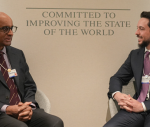You are here
Economic growth forecast at 3.7 per cent for SEMED region in 2023
By JT - Sep 27,2023 - Last updated at Sep 27,2023

Growth in Jordan picked up to 2.8 per cent year on year in the first quarter of 2023, driven by improved performance in agriculture, construction, transport and tourism, according to EBRD’s latest Regional Economic Prospects report (File photo)
AMMAN — The European Bank for Reconstruction and Development (EBRD) is forecasting modest economic growth in 2023 in the southern and eastern Mediterranean (SEMED) region, according to the bank’s latest Regional Economic Prospects report, published on Wednesday.
Gross domestic product (GDP) in the SEMED region is expected to grow by an average of 3.7 per cent in 2023 and 3.9 per cent in 2024, slightly below previous forecasts, reflecting delays to structural reforms and increased fiscal and external vulnerabilities, according to an EBRD statement.
However, the region’s economies have weathered the challenging global environment relatively well, although high inflation and tighter financing conditions have increased sovereign stress. Higher energy and food prices continue to weigh on household and government finances, although most economies in the region have reverted to fiscal consolidation in 2023.
The SEMED economies in detail
Egypt
Growth in Egypt is estimated to have slowed to 4.1 per cent in the fiscal year ending June 2023 (FY 2022-23) and is projected to rise to 4.8 per cent in FY 2023-24.
Despite a recovery in revenues from the Suez Canal and tourism, growth was weighed down by a deceleration in construction and manufacturing activities and a contraction in gas production. Natural gas output is estimated to have declined by 9.3 per cent year on year in the first half of 2023, reaching a three-year low. Meanwhile, unemployment dropped slightly to 7.0 per cent in the second quarter of 2023, with higher rates among women (19.2 per cent) and in urban areas (10.3 per cent).
The Egyptian pound has lost almost 50 per cent of its value against the US dollar since March 2022 and, coupled with elevated international commodity prices, this drop pushed inflation to a record high of 36.5 per cent in July 2023, despite a cumulative 1,100 basis points-hike in the central bank’s policy interest rate since April 2022. Foreign exchange reserves stabilised, partly thanks to an International Monetary Fund (IMF)-supported programme that improved access to external financing, but the currency is still under pressure and a significant differential remains between the official and black-market exchange rates.
Jordan
Growth in Jordan picked up to 2.8 per cent year on year in the first quarter of 2023, driven by improved performance in agriculture, construction, transport and tourism (as tourism receipts surpassed pre-pandemic levels at last). Unemployment remained high at 21.9 per cent in the first quarter of 2023, with higher rates among women (26.7 per cent) and youth (43.7 per cent). Meanwhile, inflation eased to 0.9 per cent in July 2023, following a peak of 5.4 per cent in September 2022, on the back of elevated prices for global food and energy.
The Central Bank of Jordan has raised its main policy rate by a cumulative 500 basis points since February 2022, in line with decisions taken by the Federal Reserve. GDP growth is expected to stabilise at 2.5 per cent in 2023 and 2024, supported by a continued recovery in tourism and robust growth in non-service sectors.
Nevertheless, downside risks include further increases in energy and food prices, muted private investment due to tighter monetary conditions, and possible delays in the implementation of structural reforms. Successful implementation of the reforms announced under the Economic Modernisation Plan and aimed at attracting foreign direct investment could provide a medium-term boost to growth.
Lebanon
No GDP growth is expected in 2023, amid political inaction and stalled reforms.
Uncertainty surrounding a potential IMF-supported programme has increased after the stalling of key prerequisite reforms, keeping Lebanon locked out of international markets and further depleting official reserves.
In 2024, the economy could return to growth, forecast at around 3 per cent, conditional on overcoming political hurdles, progressing on reforms and successfully implementing an IMF-supported programme, which would also allow negotiations with international partners to resume.
Morocco
Morocco’s economy has recovered from a difficult 2022, with growth rising to 3.4 per cent year on year in the first half of 2023.
Growth in 2023 is expected to be around 3.1 per cent, up from the 1.3 per cent rate recorded in 2022 when a drought compounded the adverse impact of tighter global financing conditions. These forecasts do not incorporate the effects of the earthquake that occurred in early September in the High Atlas mountains near Marrakech and led to widespread destruction and loss of life. The impact on overall economic activity remains difficult to judge at this stage; while reconstruction expenditure might provide a boost to medium-term growth, it might also increase the need for financing.
Growth in 2023 has been supported by an improved harvest and a boom in tourism, as well as slower inflation and recovering domestic demand. As a result, unemployment fell slightly to 12.4 per cent in the second quarter of 2023, with higher rates among women (17 per cent), youth (33.6 per cent) and in urban areas (16.3 per cent).
Growth is expected to reach 3 per cent in 2024, reverting to pre-pandemic levels in the medium term, with accelerated momentum on reforms potentially improving the outlook further.
Tunisia
Tunisia’s economic growth is expected to average 1.9 per cent in 2023, down from a modest post-pandemic recovery of 2.4 per cent in 2022, as adverse external conditions, high inflation and social unrest weigh on the economic outlook. Despite an expansion in tourism, financial services and the industrial sector, the slowdown has been driven by a contraction in agriculture and mining.
Unemployment declined slightly to 15.6 per cent in the second quarter of 2023 but inflation reached 9.1 per cent year on year in July 2023. The macro-fiscal situation deteriorated in 2022, with increased government spending (notably the wage bill and subsidies), leading to a budget deficit of 7.6 per cent of GDP, while public debt reached 80 per cent of GDP in 2022. As a result, the country saw downgrades by rating agencies in 2022 and 2023, while agreement on an IMF-supported programme has been further delayed.
Growth in 2024 could pick up to 2.5 per cent on the back of a strong tourism sector, phosphate sales and an agreement with the IMF.
Related Articles
AMMAN — Jordan’s economy is expected to grow by 2.4 per cent in 2022, compared with 2.2 per cent in 2021, according to an International Mone
AMMAN — Jordan has maintained its ‘BB-’ Long-Term Foreign-Currency Issuer Default Rating (IDR) with a stable outlook, according to Fitch Rat
AMMAN — The Open Market Operations Committee of the Central Bank of Jordan (CBJ) on Thursday decided to maintain interest rates on mon
















